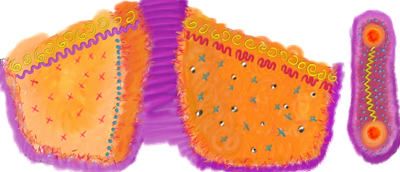| Visiting Artist Series Next Artist |
|
| |
|

|
Eni Oken has legally lived and worked in Los Angeles for the past five years, but is still a citizen of Brazil. The United States government labels her a "Resident Alien" because of this, and Eni has received some ribbing from relatives about this term. Here, Eni has illustrated her conception of a "Resident Alien," rendered in 3D Studio Max. Eni was educated in Brazil with a degree in architecture, and worked as a furniture designer before getting involved in the early days of desktop publishing and CAD. Eni is the author of three books (written in Portuguese) about CAD and computer graphics, and since coming to the United States has written several articles and given lectures on computer graphics and design. Eni now specializes in creating original 3D graphics for interactive media. You can see a lot more of Eni Oken's work at www.oken3d.com. In planning this scene, one of Eni's first concerns was choosing a color scheme for the image. The color scheme of purple, yellow, orange, pink, and blue is used throughout every part of the scene, and helps create a unity to the fanciful design. Even though Eni started with a conception of the overall scene, she created many of the elements and details as she went along, embellishing the scene as she saw fit with many creative details and ornamental decorations. The background walls and windows were modeled in Nendo, and the flowers were modeled in Animation Master, before the models were imported into 3D Studio MAX. Other parts of the scene were modeling in MAX, using a "box modeling" technique. Starting with basic primitives such as a box, forms such as the resident's head were blocked-out at a low resolution, and then increasingly smoothed with MAX's smooth operator as more detail was added. To connect the hands and feet to the limbs, MAX's Connect operator was used to stitch together the separate polygon meshes. To align the texture maps with the geometry, complex forms such as the chair model were brought into Tru-V to be unfolded. Tru-V was used to output a reference picture of the unfolded geometry, and also to add new UV texture coordinants to the model before it was reimported to MAX. For some simpler models, MAX's built-in unwrap function was also used. Eni painted the texture maps from scratch in Metacreations Painter, adding detailed ornamental patterns throughout the scene. Adobe Photoshop was used to process the images and assemble the maps into layers before they were applied in 3D Studio Max. The texture map below is what Eni painted to wrap around the armrest of the chair. |
